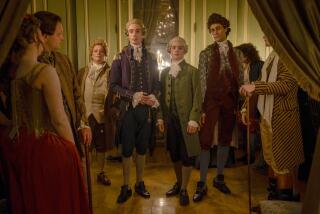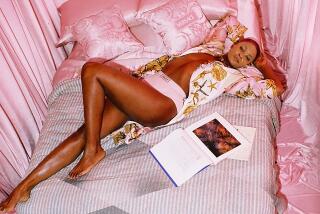Casbah Caper : Invitation to Royal Affair Puts Americans on the Exotic Road to Morocco
- Share via
MARRAKECH, Morocco — . . . The local inhabitants, dressed in their burnooses of various colors and patterns, are themselves a permanent picture; every countryman is a possible painting, every crowd is a pictorial composition . . . --Winston Churchill
That’s the way Winston Churchill described the desert chic of the Moroccans who charmed him when he came here to Marrakech to relax and paint in the ‘40s and ‘50s. He called it “The Paris of the Sahara.”
Last week, several Angelenos, New Yorkers and Washingtonians packed their best burnooses and headed for this exotic locale set in a palm grove beneath the snow-capped High Atlas mountains of North Africa. They were all special guests of Morocco’s King Hassan II, who was celebrating his silver jubilee, the 25th anniversary of his reign as both king and caliph--both head of state and commander of the faithful.
The cast of celebrities, socialites and politicos for this version of “Road to Morocco” included, from Los Angeles, Hollywood costume designer Jean Louis and his wife, Maggy (he made his first trip to Morocco in 1930 and once made clothes for the king’s late sister, Princess Lalla Nezah), Rosemarie and Robert Stack, Pat and Michael York, Barbara Eden and her friend Dr. Stanley Frileck (the Brentwood plastic surgeon), Nancy and John Bryson (he’s a celebrity photographer) and Architectural Digest editor Paige Rense, who hoped to do a little scouting for the pages of her magazine between events.
Designer Mary McFadden organized a New York group that included, among others: Jerry Zipkin, good pal of Nancy Reagan (he conveyed a special message to the king, but wouldn’t tell anybody what it was or who it was from), and jewelry designer Kenneth Jay Lane.
Among those from Washington were William J. Casey, director of the CIA, who was decorated with the Order of the Throne by the king during the festivities, and Vernon A. Walters, U.S. Ambassador to the United Nations and a close friend of the king.
What do you pack to wear to festivities held in ornate palaces out of the Arabian Nights, to a luncheon set in carpeted tents, to a tea served in the harem of the royal court?
In Marrakech, you see everything from barely covered belly dancers at the Grand Hotel La Mamounia to barely visible Arab women on the streets swathed from head to toe, save their eyes. Men in their fezzes and flowing robes are often as elaborately dressed as the women.
For the American nomads, who changed outfits about five times a day, designer labels with touches of glitter for a little “come with me to the casbah” glamour was the popular look.
Maggy Louis packed an entire wardrobe by James Galanos. She explained that her designer husband doesn’t get jealous when she wears Galanos because Mr. Louis “helped give Galanos his start in Hollywood.”
Pat and Michael York also stuck to one label with complete Giorgio Armani wardrobes for both.
“Once you wear Armani, you don’t want to wear anything else,” said the film star, who is a friend of the designer.
Rosemarie Stack seemed to pack an entire wardrobe of short and long dresses with fanny wraps and a certain Moroccan flair in the fabrics, from Islamic floral prints in fuchsia and purple to solid gold lame.
“I didn’t buy anything special for the event, but I did pack with the mood and atmosphere of the country in mind,” said Stack.
For the afternoon celebration of the king’s accession to the throne, outdoors in a palace courtyard, straw hats and white suits were the favorite look. Paige Rense wore white and accented the neckline with two gold necklaces--one antique Victorian and one by Elsa Peretti--which she thought “had that Moroccan look.”
Rense says she also made a point of packing lots of flat shoes. “I want to be comfortable, so no high heels. I’m only 5-foot-2, but I’ve learned that another two inches aren’t worth the pain you go through when you’re traveling.”
Though guests had been told before they left American soil that there would be two black-tie galas, there were ultimately no such events on the actual schedule.
As fate would have it, however, those long gowns that made the long journey from America to Africa turned out to be appropriate, in fact de rigueur , for a “for women only” afternoon tea given by the ladies of the court at the harem of the royal palace. The Arab custom of purdah requires women be covered up at such official events--so out came the long gowns.
Barbara Eden didn’t wear the midriff-baring “I Dream of Jeannie” outfit she made famous on her television series, even though her character may have been based on an old Islamic myth. But she wasn’t exactly covered up either in an all-out, Hollywood glamour-girl gown of white silk crepe by Ellene Warren accented with a white fox fur.
“The women at tea were very exotic and colorful, and I’ve never seen so many beautiful jewels in my life,” Eden said.
One man did manage to crash the party. The king made a surprise appearance and greeted each of the visitors.
“They asked your name, you curtsied and he took your hand,” Stack recalled. “He has a very strong handshake.”
The king wore traditional white djellaba and yellow slippers with pointed toes for both his celebration of the accession to the throne in the palace and to the ceremony of the oath of allegiance from his subjects in another exterior courtyard the following day. For the latter ceremony, the king was at his most regal, riding on a black Arabian horse decorated with gold saddle and gold hoofs, a purple umbrella held high above his head and followed by a gilded coach that once belonged to Queen Victoria.
Robert Stack wore his Olympic tie for the throne ceremony. He’s on the Olympic advisory committee for the shooting team. Kenneth Jay Lane looked Edwardian in a double-breasted, striped suit and a massive shawl wrapped across his neck and shoulders to ward off the cold when the winter Sahara sun begins to set.
Mary McFadden didn’t have to give her wardrobe a second thought. Her collections are known for their exotic, ethnic scenes, and several have been inspired by Islamic design. She has also lived in Africa for five years working as a journalist. Even the fur McFadden wore for the flight from frigid New York to Marrakech had an Islamic design.
Observing the American women and the women of the Moroccan court at tea, McFadden noted: “White and gold are the predominant colors worn in Morocco.”
She wore one of her Berber black pleated gowns with jeweled collar and cuffs to the tea and a large brass and gold Islamic pin on the chest of her white ensemble one afternoon.
After palace hopping and partaking of couscous, pastilla and green tea under huge tents with carpeted floors, the next most fashionable activity was hitting the souks, the open-air markets.
McFadden bought a gold-embroidered caftan for herself and some crocheted buttons she wants to copy and put in a future collection. Eden and Frileck bought rugs for her car and djellabas so they could explore unrecognized in southern Morocco. Rense bartered for a Berber-painted, leather jewel box and a coral necklace to put in it. And Lane picked out a djellaba to bring home as tribute to Diana Vreeland, the woman many call the empress of fashion.
More to Read
Sign up for The Wild
We’ll help you find the best places to hike, bike and run, as well as the perfect silent spots for meditation and yoga.
You may occasionally receive promotional content from the Los Angeles Times.






